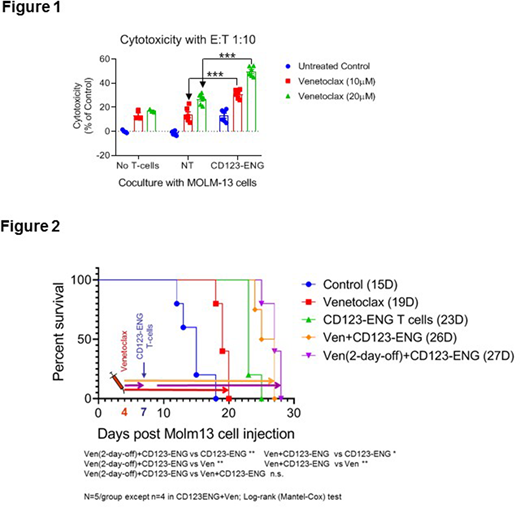Background: CD123 is frequently expressed in hematologic malignancies including AML. CD123 has been a potential immunotherapeutic target in AML due to its association with leukemic stem cells that play an essential role in disease progression and relapse. Our previous study using T-cells secreting CD123/CD3-bispecific T-cell engagers (BiTEs) (CD123-ENG T-cells) has shown activity in preclinical studies, recognizing and killing acute myeloid leukemia (AML) blasts in vitro and in vivo. CD123-ENG T-cells secrete bispecific molecules that recognize CD3 (T-cells) and CD123 (AML blasts), and are able to direct transduced T-cells and recruit bystander T-cells to kill CD123-positive blasts. Venetoclax is a BCL-2 inhibitor that can restore functional apoptosis signaling in AML cells, and has been FDA approved for the treatment of AML patients in combination with hypomethylating agents. To improve the efficacy of CD123-ENG T-cells we explored efficacy in AML by combining targeted immunotherapy (CD123-ENG T cells) with targeted inhibition of anti-apoptotic BCL-2 (venetoclax) in vitro and in vivo models of AML.
Methods: CD123-ENG T-cells were generated by retroviral transduction and in vitro expansion. Non-transduced (NT) T-cells served as control. In vitro, GFP+ MOLM-13 AML cells were pretreated with venetoclax (0, 10µM, and 20µM) for 24 hours prior to co-culture with CD123-ENG or NT T-cells at an effector/target ratio of 1:10. After 16 hours, MOLM-13 AML cells were analyzed by flow cytometry and quantitated using counting beads; cytotoxicity was calculated relative to untreated MOLM-13 control. The anti-AML activity of the combination was further evaluated in a MOLM-13-luciferase xenograft AML mouse model. Leukemia progression was assessed by bioluminescence imaging. The frequency of MOLM13 AML and human T cells in periphera blod (PB) was determined by flow cytometry.
Results: In vitro, we demonstrated that pretreatment of Molm13 AML cells with venetoclax enhanced the cytolytic activity of CD123-ENG T-cells compared to NT- or no T-cell controls. Interestingly, venetoclax sensitized Molm13 to CD123-ENG T-cell killing in a dose-dependent manner (Fig.1; 50%/31% killing by CD123-ENG T-cells versus 27%/14% of killing by NT T cells post pretreatment with 10µM or 20µM ventoclax, p<0.001). In the Molm13 luciferase xenograft model, NSGS mice were randomized into 5 groups after AML engraftment was confirmed: 1) vehicle control, 2) Venetoclax (Ven) only, 3) CD123-ENG T-cells only, 4) Ven+CD123-ENG T-cells, 5) Ven+CD123-ENG T-cells/2-day-off Ven post T-cell infusion (Ven[2-day-off]+CD123-ENG). Venetoclax treatment (100 µg/kg daily via oral gavage) was started on day 4 post Molm13 injection, and on day 7, mice received one i.v. dose of CD123-ENG T-cells (5x106 cells/mouse). Venetoclax or CD123-ENG T-cell monotherapy reduced leukemia burden compared to the control group, and combinational treatments further inhibited leukemia progression as judged by BLI and circulating AML cells (%GFP+mCD45-/total live cells) by flow cytometry on day 15 post MOLM-13 injection: vehicle control: 19.6%; Ven+: 3.4%; CD123-ENG T-cells:1.2 %; Ven+CD123-ENG T-cells: 0.3%; Ven[2-day-off]+CD123-ENG T-cells (p<0.01 Ven+ or CD123-ENG T-cells versus control; p<0.001 Ven+CD123-ENG or Ven[2-day-off]+CD123-ENG T cells versus CD123-ENG T cells, n=5). The enhanced anti-AML activity of combining venetoclax and CD123-ENG T-cells translated into a significant survival benefit in comparison to single treatment alone (Fig. 2). However, while Ven+CD123-ENG and Ven[2-day-off]+CD123-ENG T-cell treated mice had a survival advantage, they had reduced circulating numbers of human CD3+ T cells on day 8 post T-cells infusion compared to mice that received CD123-ENG T-cells, indicative of potential adverse effect of venetoclax on T-cell survival in vivo.
Conclusion: Our data support a concept of combining pro-apoptotic targeted and immune therapy using venetoclax and CD123-ENG T-cells in AML. While it has been reported that venetoclax does not impair T-cell functionality, more in-depth analysis of the effect of Bcl-2 inhibition on T-cell function and survival appears warranted, as it could diminish survival not only of AML blasts but also of immune cells.
Bonifant:Patents filed in the field of engineered cellular therapies: Patents & Royalties: Patents filed in the field of engineered cellular therapies. Gottschalk:Patents and patent applications in the fields of T-cell & Gene therapy for cancer: Patents & Royalties; Inmatics and Tidal: Membership on an entity's Board of Directors or advisory committees; Merck and ViraCyte: Consultancy; TESSA Therapeutics: Other: research collaboration. Velasquez:Rally! Foundation: Membership on an entity's Board of Directors or advisory committees; St. Jude: Patents & Royalties. Andreeff:Amgen: Research Funding; Daiichi-Sankyo; Jazz Pharmaceuticals; Celgene; Amgen; AstraZeneca; 6 Dimensions Capital: Consultancy; Daiichi-Sankyo; Breast Cancer Research Foundation; CPRIT; NIH/NCI; Amgen; AstraZeneca: Research Funding; Centre for Drug Research & Development; Cancer UK; NCI-CTEP; German Research Council; Leukemia Lymphoma Foundation (LLS); NCI-RDCRN (Rare Disease Clin Network); CLL Founcdation; BioLineRx; SentiBio; Aptose Biosciences, Inc: Membership on an entity's Board of Directors or advisory committees.
Author notes
Asterisk with author names denotes non-ASH members.


This feature is available to Subscribers Only
Sign In or Create an Account Close Modal